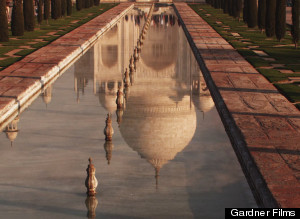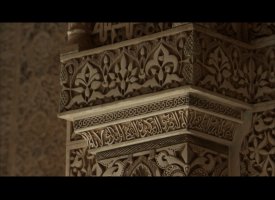HUFFINGTON POST

When I first traveled in Spain, the Alhambra Palace and its summer gardens were not yet tourist magnets attracting millions every year. Their beauty is indescribable, but when I first visited, it was nearing midnight. As I climbed the long hill to the deserted medieval walls, I couldn’t see a thing.
Built to house the last generations of Grenada’s Muslim rulers, Alhambra is the palace that Queen Isabella coveted and finally claimed in 1492. When I reached the unguarded entrance it was padlocked. Nearby I discovered a length of stone wall lower than the rest, with an olive tree growing beside it. I threw my sleeping bag over the wall, climbed the tree, and jumped down inside.
The palace grounds were dark. The first thing I heard, then finally saw by moonlight, was the sound and shimmer of a sheet of water: overflowing a fountain basin, water softly winding into a long, reflecting pool.
If one were living in a bone-dry desert, I wondered, confined to a landscape of two colors — hard blue above and pale brown beneath — how would one imagine Paradise? If water never flowed on your patch of Earth, wouldn’t you fill your Paradise with fountains and cool streams? If your weather consisted of relentless sun and sandstorms, you’d imagine shade and gentle wind. If your only trees were low and scrubby, you would dream up orchards. There would be expansive flower beds, profusions of pastel colors, ripe fruit and perfume in traces on a breeze. Yes, if you lived in the desert, your version of paradise would probably be a palatial garden like in Alhambra Palace, guarded by high, surrounding walls. It’s no surprise, then, that our word “Paradise” derives from a nearly identical Persian word meaning “walled garden.”
Such is the vision of the “Better World” that Islamic civilization created from the eighth century onward, as the first Arab settlers streamed out of their barren peninsula for cooler climates and richer lands — into Syria, Palestine, Morocco, Southern Spain, Mesopotamia, Afghanistan, India, Indonesia and China. In the great capitals as well as in smaller cities and towns, these intrepid empire-builders managed to create great palace-garden complexes, like photographic negatives of the grim sand waste they once called home. And in each of these magic-carpet kingdoms, water is the central element.
Coming back to the Alhambra years later as a filmmaker (I returned to film “Islamic Art: Mirror of the Invisible World,” which premieres this Friday as part of the PBS Arts Summer Festival), I realized how big a role water plays here. The expansive, summer gardens, for instance, have at their centers long, narrow pools overarched by thin, sprays of water that crisscross in the air. I found the same central role for water in the other great buildings: The Topkapi Palace in Istanbul, the Grand Mosque at Damascus, and the Taj Mahal in India — among many other famed Islamic buildings — are similarly enhanced by extensive water gardens in their midst.
Water plays multiple roles in all these places. It nourishes the fruit trees that shade the gardens. It cools the pungent air. It lays moisture on the budding flowers of a hundred Old World roses. It unites the low buildings and the grounds. It’s a natural source of “white noise” too, masking clashing sounds from the surrounding city and wrapping the garden in a tranquil patter. Time stops in places like these, resulting in an unearthly equilibrium.
This use of water to create paradisiacal settings isn’t limited to spectacular pleasure palaces of the ruling class. Along the winding, narrow channels of every oasis in the Sahara, on the smallest plots of land where date palms grow, farmers over the centuries have set aside little nooks of shade and flowing water, furnished with a couch or hammock, where a soft breeze and the music of a stream can refresh the soul.
Oases and the ingenious use of water equip the Nile and the Euphrates too, with little corners of heaven to escape to. In all the dry lands of the Muslim world, from Morocco across the Middle East, South Asia and China, water has been carefully channeled to make the dry earth bloom.
In Persia, a thousand years before the first water pump, agricultural experts applied the laws of hydraulics to perfect what they called the qanat system. Qanat is a series of wells sunk deep into the earth, then linked by tunneled channels that carry water over great distances; still today they overcome the challenges of gravity and geography to supply crops with the moisture they require, doubling the growing seasons, bringing a surplus of food to regions where there would otherwise be famine.
A version of this technique, carried from Syria to medieval Spain by the Arabs, was introduced into the New World by early Spanish settlers after 1492. Similar systems are used in the American southwest today.
And wherever these irrigation systems serve farms and orchards, you still can see the small walled gardens and retreats among the palm trees, providing hard working people a modest corner of Paradise.
Michael Wolfe is the Co-Executive Producer of “Islamic Art: Mirror of the Invisible World,” a 90-minute documentary to be broadcast nationally on PBS July 6th at 9pm (check local listings) as part of the PBS Arts Summer Festival. The Festival is a seven-part series that featuring artists and performances from nine different communities around the country, and underscores PBS’s ongoing commitment to provide viewers a front-row seat and a back-stage pass to the art-making process. See below for a clip about calligraphy, from the film.
.







